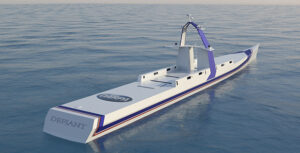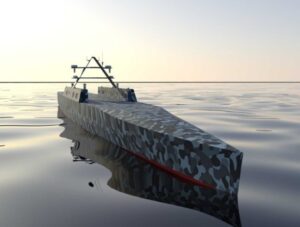The Defense Advanced Research Projects Agency (DARPA) said it selected Serco Inc. to move forward with the No Manning Required Ship (NOMARS) X-ship medium unmanned surface vessel (MUSV) program.
NOMARS is a two-phase DARPA program that seeks to demonstrate the reliability and feasibility of a USV operating long missions at sea autonomously with entirely no manning.

DARPA underscored this program takes a “clean-sheet approach to ship design, holding firmly to the requirement that there will never be a human on board the vessel while it is at sea – including during underway replenishment (UNREP) events. By eliminating all constraints and requirements associated with humans, NOMARS opened up the design space to novel ship configurations and capabilities that could never be considered for crewed vessels.”
Previously, DARPA said after the Phase 1 exploration of trade space, Phases 2 and 3 would have a contractor build prototype hardware to demonstrate concepts, leading to an X-ship seaframe for demonstrations and future experiments. Phase 2 is expected to entail risk reduction on enabling technologies and ship design concepts, detailed design and construction and eventually initial at-sea demonstrator testing.
“NOMARS plans to demonstrate a next-generation completely unmanned ship that will enable entirely new concepts of operations. We will enable methods of deploying and maintaining very large fleets of unmanned surface vessels that can serve as partners, across the globe, for the larger crewed combatants of the U.S. Navy,” Gregory Avicola, program manager at DARPA’s Tactical Technology Office, said in a statement.
DARPA said since NOMARS will have no crew for maintenance, it requires new methods for power generation, propulsion, machinery line-up and control schemes “to ensure continuous functionality throughout a long mission in all weather, temperature, and sea states.”
DARPA said in Phase 1 Serco used a new Design Space Exploration (DSX) toolset that can evaluate spaces with various parameters and then compute millions of ship designs that meet a set of performance objectives and constraints.
In this case, the agency said Serco used DSX to create ship designs ranging from 170-270 metric tons and then refined those into one ship, called Defiant, for the preliminary design review. The final design will be 210 metric tons.
Next, in Phase 2, Serco will finalize ship design, build the prototype ship, and work through testing activities before it goes to sea for a three-month testing demonstration.
Serco’s partners on NOMARS include Beier Integrated Systems LLC, Caterpillar [CAT], Leonardo’s DRS Naval Power Systems Inc., ICE FLOE LLC doing business as Nichols Brothers Boat Builders, Metron Inc., Submergence Group LLC, and Thrustmaster of Texas Inc.

DARPA argued Defiant will be the first MUSV of its kind, seeking to “maximize performance, reliability, and maintenance efficiency while still carrying significant payload at tactically useful ranges.”
The agency said its goal is to achieve “ultra-reliability objectives” via integrating distributed hybrid power generation, podded propulsors, and high-capacity batteries.
DARPA noted the NOMARS program is focused on a “graceful degradation” philosophy, meaning individual parts can fail over time because there will be enough system-level redundancy to meet requirements of reaching at least 15 knots after one year at sea. The design also has modularized system components that allow repairs to use equipment typically found in yachts around the world.
“This maintenance philosophy supports rapid turnaround, allowing the ships to spend a majority of their lifetime at sea performing missions,” DARPA said.
Almost a year ago, Serco said it finished Phase 1A concept design for NOMARS and was selected for preliminary design, Phase 1B. Then the company said it was next going to further define top-level and derived requirements during the System Requirements Review (Defense Daily, Sept. 24, 2021).
At the time, Serco noted these kinds of MUSVs can help decrease the Navy’s cost per mission hour, extending observation of larger swatches of the mission space and allowing commanders to be “everywhere at once” with less risk to naval crewmembers.
Originally, in October 2020 DARPA awarded Phase 1 of NOMARS to seven contractors. Autonomous Surface Vehicles, LLC, Gibbs & Cox Inc., and Serco Inc. received Phase 1 Track A awards, directed to work toward developing novel NOMARS demonstrator conceptual designs.
Barnstorm Research Corporation and TDI Technologies, Inc. won Phase 1 Track B awards, directed to develop “robust approaches to ship health-monitoring via novel Self-Adaptive Health Management (SAHM) architectures, which will be pivotal to achieving NOMARS at-sea endurance and reliability objectives.”
InMar Technologies and Siemens Corp. also received Phase 1 Track B awards focused on developing new techniques to morph hull structures to maximize performance and also implanting toolsets previously developed via the DARPA TRADES program to design optimized material structures for novel ship concepts, respectively.
In March 2021, DARPA added L3Harris Technologies [LHX] for NOMARS Phase 1 (Defense Daily, March 2, 2021).